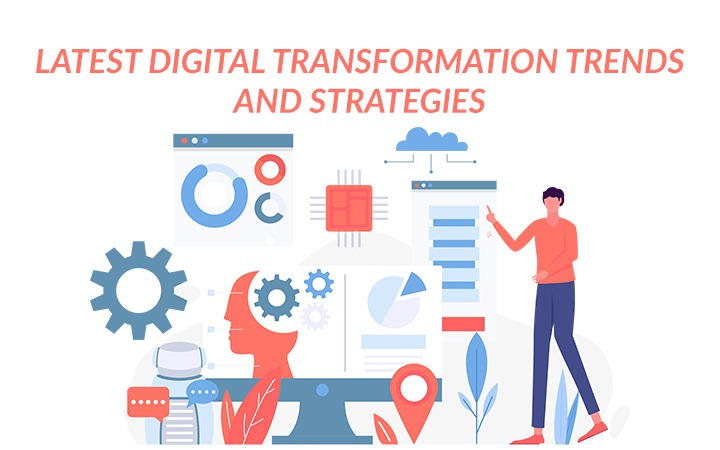Digital transformation trends are not just a buzzword or a passing trend, but a necessity for businesses to survive and thrive in today’s digital age. It is about leveraging technology to enhance operations, improve customer experience, and drive innovation.
This blog aims to provide an overview of the latest digital transformation trends and strategies that businesses can leverage to stay ahead of the curve.
So, let’s dive in…
Low-code platforms are more widely adopted
Low-code platforms are a trend in digital transformation that has been gaining traction over the past few years. Low-code platforms enable businesses to create and deploy applications with minimal coding, using visual interfaces and drag-and-drop functionality. This allows companies to develop and iterate on applications more quickly, reducing the time to market and improving agility. Low code platforms also help to democratize application development, as more employees can participate in the development process without requiring extensive coding skills. As low-code platforms continue to evolve and improve, we can expect to see even wider adoption in the years to come.
A rise in cloud migration
The migration to the cloud has been a trend in digital transformation for several years now, but it shows no signs of slowing down. With cloud computing digital transformation, businesses can access scalable and flexible IT resources that can be deployed quickly and easily. Cloud computing digital transformation trends can help companies to be more agile, reduce IT costs, and improve scalability. In addition, the cloud enables businesses to access a wider range of services and applications, including storage, computing power, and software-as-a-service (SaaS) solutions. As more businesses continue to migrate to the cloud, we can expect to see even greater innovation and development in cloud computing digital transformation.

Machine learning and Artificial Intelligence
Artificial intelligence (AI) and machine learning (ML) are key trends in digital transformation. AI and ML can be used to automate business processes, improve customer experiences, and enhance decision-making capabilities. For example, AI-powered chatbots can improve customer service experiences by providing 24/7 support, while machine learning algorithms can analyze customer data to identify patterns and insights. In addition, AI and ML can help businesses to optimize their operations and reduce costs, leading to increased efficiency and productivity. As these technologies continue to advance, we can expect to see even greater adoption in a wide range of industries.


Intelligent search
Intelligent search is another trend in digital transformation that is gaining momentum. The intelligent search uses AI and machine learning algorithms to deliver more relevant and accurate search results. This can help businesses to improve the customer experience, as customers can find what they are looking for more quickly and easily. Intelligent search can also help businesses to improve internal search functionality, enabling employees to find the information they need more efficiently. As the volume of data continues to grow, we can expect to see even greater adoption of intelligent search technologies.
Internet of things (IoT)
Internet of Things (IoT) devices are rapidly becoming more common in many industries and can provide businesses with real-time insights into customer behavior, operational efficiency, and product performance. IoT devices can also be used to automate processes and enhance operational efficiency, leading to improved productivity and cost savings. However, businesses need to ensure that they have robust cybersecurity measures in place to protect their IoT devices and data from cyber threats.
Rise of 5G networks
The rise of 5G networks is also driving digital transformation. 5G networks offer faster and more reliable connectivity, enabling new applications and use cases. For example, 5G can support the real-time streaming of high-quality video and enable the use of augmented and virtual reality (AR/VR) applications. 5G can also enable the processing of massive amounts of data in real time, providing businesses with new insights and opportunities.
Cybersecurity

Cybersecurity is a critical consideration in any digital transformation strategy. As companies move more of their operations online, they are exposed to greater risks, such as cyber-attacks and data breaches. Businesses need to ensure that they have robust cybersecurity measures in place to protect their data and operations. This may include implementing firewalls, access controls, and encryption technologies, as well as regular employee training on cybersecurity best practices.
Employee engagement and Upskilling
Employee engagement and upskilling is a key aspects of digital transformation. Businesses need to ensure that their employees have the skills and knowledge to leverage new technologies and processes effectively. This may involve training, upskilling, and even cultural change initiatives to foster a more innovative and tech-savvy workforce. Engaged and empowered employees can help businesses to achieve their digital transformation goals more effectively.
Digital Transformation Strategy Roadmap
The process of digital transformation can seem overwhelming, but having a solid strategy roadmap can make all the difference. A digital transformation strategy roadmap outlines the steps required to successfully implement digital transformation initiatives in an organization.
Here are some key steps to consider when developing a digital transformation strategy roadmap:
Assess the current state of your organization
Before embarking on any digital transformation initiative, it’s essential to evaluate the current state of your organization. This includes assessing your existing technology infrastructure, processes, and workforce capabilities.
Identify business objectives
Once you have a clear understanding of your organization’s current state, you can start identifying your business objectives. These objectives should be aligned with your organization’s overall strategy and should focus on delivering value to your customers.
Establish a clear scope for your digital transformation efforts
Based on your business objectives, you can define the scope of your digital transformation initiatives. This includes identifying the specific areas of your organization that require digital transformation, such as customer engagement, supply chain management, or employee productivity.
Develop a roadmap
With a clear understanding of your business objectives and the scope of your digital transformation initiatives, you can develop a roadmap that outlines the steps required to achieve your goals. This roadmap should include timelines, budgets, and resource requirements.
Implement and monitor
Once your roadmap is in place, you can start implementing your digital transformation initiatives. It’s important to monitor your progress regularly and make adjustments as necessary to ensure you’re on track to achieving your objectives.
A digital transformation strategy roadmap is a critical component of any successful digital transformation initiative. By following these key steps, you can develop a roadmap that sets you up for success and helps you achieve your business objectives.
Examples of Most Successful Digital Transformation Companies
Here are some examples of the most successful digital transformation companies that have been able to improve their efficiency, increase their revenue, and gain a competitive edge in their respective markets.
Amazon
Amazon is a prime example of a company that has undergone successful digital transformation companies. By leveraging digital technologies, Amazon has been able to disrupt traditional retail models and build a business that has become a household name. Amazon’s success can be attributed to its ability to leverage data analytics, cloud computing, and artificial intelligence to drive innovation and improve customer experience.
Netflix
Netflix is another company that has successfully undergone digital transformation. By leveraging digital technologies, Netflix has been able to disrupt the traditional entertainment industry and build a business that has become a global phenomenon. Netflix’s success can be attributed to its ability to leverage big data analytics to drive innovation and provide personalized content recommendations to its users.
Uber
Uber is a prime example of a company that has disrupted the traditional transportation industry through digital transformation. By leveraging mobile technology, cloud computing, and data analytics, Uber has been able to build a business that has become a household name. Uber’s success can be attributed to its ability to leverage digital technologies to improve efficiency, reduce costs, and improve customer experience.
Airbnb
Airbnb is another company that has disrupted the traditional hospitality industry through digital transformation. By leveraging digital technologies, Airbnb has been able to build a business that has become a global phenomenon. Airbnb’s success can be attributed to its ability to leverage data analytics and mobile technology to provide personalized experiences to its users.
Whether you need to automate processes, migrate to the cloud, adopt AI and machine learning, or implement intelligent search, our team of experts can help you navigate the latest digital transformation trends and implement strategies that are tailored to your business needs. Get in touch with us now to learn more about how our digital transformation services can help your business stay ahead of the curve and thrive in today’s rapidly evolving digital landscape.



